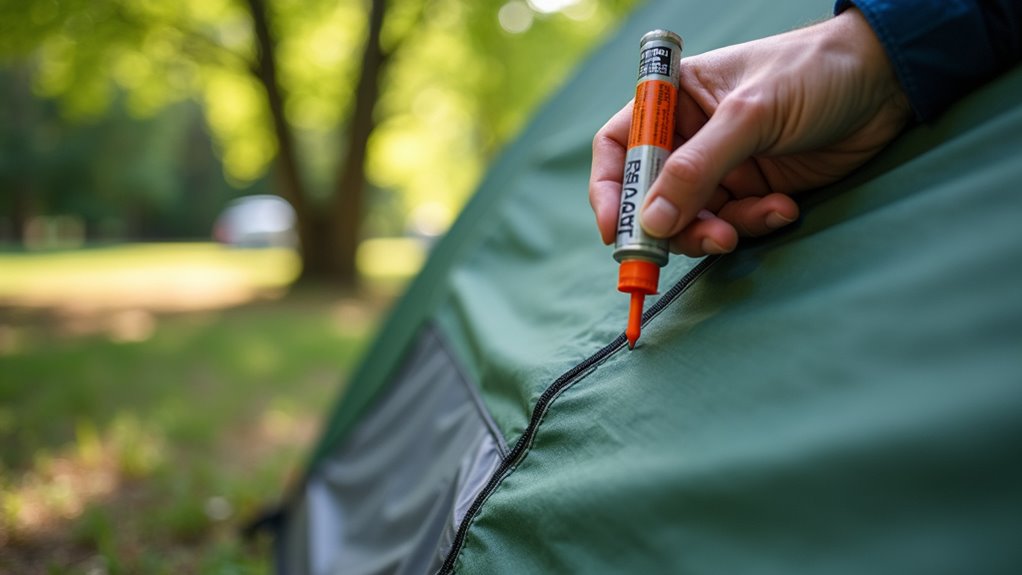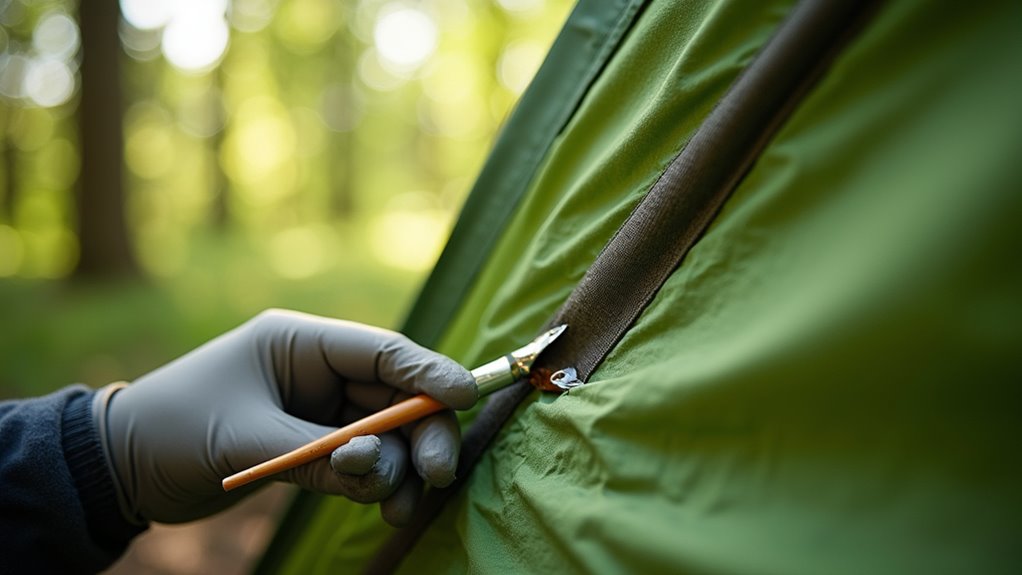How Do You Seam Seal A Tent
This post contains affiliate links. As an Amazon Associate, we earn from qualifying purchases.
Seam sealing a tent involves applying a suitable sealant along the seams to ensure waterproof protection. Begin by pitching the tent on a dry day, cleaning the seams thoroughly, and then applying a thin, even line of sealant designed for your tent’s coating. Further steps and detailed instructions on selecting the right sealant and application techniques are provided below for a more comprehensive guide.
Essential Facts in 30 Seconds
- Set up the tent on a dry, warm day and check seams for loose tape.
- Select a sealant compatible with your tent fabric, like silicone or urethane-based.
- Clean seams with rubbing alcohol and mask nearby areas to avoid overspill.
- Apply a thin line of sealant along seams, covering all stitches evenly.
- Let the sealant cure for 2 to 24 hours in a ventilated area before use or storage.
Preparation for Seam Sealing
Prepare your tent well before sealing the seams. Set up the tent on a dry, warm day. This helps the sealant dry and stick better.
Check all seams carefully. Remove any loose seam tape to make the sealant stick well. Spread the tent flat and tight to see all seams clearly. Cover parts like zippers and mesh with masking tape to keep them clean.
Clean the seams with rubbing alcohol or a mild cleaner. Let them dry completely. Press each seam gently with a roller or your fingers. Don’t stretch the fabric.
These steps help sealant work perfectly and keep your tent waterproof.
Choosing the Right Seam Sealant
Pick a seam sealant based on your tent’s fabric type.
Silicone sealants suit silicone-coated tents best. Urethane-based sealants, like Gear Aid Seam Grip FC, work well on polyurethane-coated tents.
Matching the sealant to your tent’s coating ensures strong waterproofing. It also protects the fabric from damage. Additionally, checking the waterproof ratings of your tent can guide you in selecting the most effective sealant.
Use the right sealant for lasting results and dry adventures.
Silicone vs. Liquid Sealants
The right seam sealant can make your tent last longer and work better.
Silicone and liquid sealants have different strengths. Liquid sealants dry fast, usually in about two hours. They’re thin, so you can spread them easily. This makes them great for quick fixes. Additionally, consider regular maintenance to keep your tent in optimal condition.
Silicone sealants take longer to dry, up to 24 hours. They stand up better to sunlight and last longer outside. Silicone is thick and may need thinning before use.
Both types stop water from getting into your tent. Think about where and how you’ll use your tent before choosing. Your choice affects how well your tent stays dry and strong. Regular maintenance ensures longevity of the tent and enhances your camping experience.
Compatibility With Fabrics
The right seam sealant keeps your tent strong and waterproof.
Different fabrics need different sealants. Polyurethane (PU) fabrics bond well with PU-based sealants like Seam Grip TF. Silicone-coated fabrics need silicone sealants. PU sealants won’t stick, causing leaks.
Silnylon tents have silicone on both sides. Use silicone sealants to keep them safe.
Always clean seams before applying sealant. Sealants like Seam Grip TF work best between 60°F and 100°F. Regularly check the tent for leaks to ensure that your waterproofing efforts remain effective.
Use the right sealant to make your tent last longer and stay dry in all weather.
Application Process

Pitch your tent fully in a place with good air flow. This lets you reach every seam easily. Keep the fabric tight, especially along the ridgeline seam.
Clean the seams using rubbing alcohol or a mild cleaner. Remove any dirt and old sealant. Let seams dry well before moving on. Use masking tape to protect nearby fabric and zippers from the sealer.
Shake the sealing product as the instructions say. Apply a thin, steady line of sealer along the entire seam. Cover all stitches completely.
Use a small brush to push the sealer into the fabric fibers. Focus on corners and places where the tent pulls tight. Smooth the sealer to stop it from pooling. This helps cover the seam evenly.
After it dries, check for weak spots or gaps. Apply more sealer if needed to keep water out.
Post-Application and Curing
After applying the seam sealer, focus on curing to ensure a strong waterproof seal.
Let the sealant dry for 2 to 24 hours. The exact time depends on the product and weather.
Place your tent in a clean, well-ventilated area. This helps the seal dry properly.
Don’t touch or pack the tent until the seal dries completely. Handling it too soon can break the seal.
Store the tent in a dry spot after curing. This keeps the seal working well.
Keep pets and children away during drying. Some sealers give off strong fumes.
After the seal dries, check for any missed areas. Apply more sealant if needed.
Regular checks help keep your tent waterproof for many trips.
Maintenance and Durability

Regular checks keep your tent in great shape. Proper ventilation is essential to prevent moisture buildup, which can lead to condensation and mold. Rain and strong weather wear down the fabric and seams. Seams need resealing after wet or rough use. This stops water from leaking inside.
Fixing small problems early saves money later. A well-kept tent lasts many trips. It stays strong, dry, and safe for camping. Proper care, including applying seam sealer, means better adventures every time.
Regular Inspections Needed
Regular tent inspections keep your gear strong and ready. Check seams before and after each camping trip.
For tents used less often, inspect every 3 to 6 months. Harsh weather? Inspect twice per season to catch damage early.
Focus on corners and zippers—these spots break first. Use bright light to spot loose tape or frayed fabric. Additionally, identifying the leak early can help you address issues before they worsen.
Early fixes save money and keep your tent safe for many trips. Don’t skip regular checks. Your tent will last longer and work better. Additionally, ensure to check for leaks as part of your inspection routine to maintain tent integrity.
Resealing After Exposure
Preserving your tent’s waterproof quality needs regular care. Sun, rain, and wind wear down seam sealants. Clean seams with mild soap or rubbing alcohol. Let them dry fully before adding sealant. Use the right seam sealant, like Seam Grip, for nylon or polyester tents. Spread a thin line inside the seams with a brush or fingers. Turn your tent inside out to reach all areas easily. Work from top to bottom. Let the sealant dry for 1 to 3 hours at temperatures above 60°F. Regularly check seams for cracks, as proper maintenance can prevent leaks. Reseal every two years to keep your tent strong and dry. Additionally, regular maintenance such as cleaning and proper storage extends the lifespan of the tent.
Differences Between Seam Sealing and Seam Taping
Seam sealing and seam taping both stop water from leaking into tents. They work in different ways and suit different needs.
Seam taping uses a strong plastic tape under the seams. It blocks water from needle holes made during sewing. Factories usually add seam tape when making tents. This method offers long-lasting protection.
Seam sealing uses a liquid sealant. People brush or pour it on the outside or inside of seams. It soaks into the stitching holes and keeps water out. This method allows fixing leaks after buying the tent. You can reapply the sealant if needed.
Both methods keep tents dry and safe. Seam taping lasts longer but seam sealing lets you repair leaks anytime. Pick the best method based on how you use your tent.
Frequently Asked Questions
How Often Should I Seam Seal My Tent?
Check your tent seams at the start of every camping season. Leaks or worn areas mean it’s time to re-seal. Seam sealing keeps your tent waterproof and strong. Many campers re-seal once a year or after heavy use. Good care helps your tent last longer and stay dry. Don’t wait for rain to find leaks—seal early!
Can I Use Any Sealant for All Tent Fabrics?
Not all sealants work well with every tent fabric. Using the wrong one can cause leaks and damage. Tent fabrics like nylon, polyester, and canvas need specific sealants. Silicone-based sealants suit nylon and polyester best. Acrylic sealants work well on canvas tents. Applying the correct sealant keeps your tent dry and strong. Always check the tent fabric type before buying sealant. This simple step saves you from wet gear and cold nights. Good sealants last longer and protect better. Keep your camping trips dry and comfortable with the right sealant.
What Tools Do I Need for Seam Sealing?
For seam sealing, gather these tools: mini brushes, clean cloths, and gloves. Use PU-based or silicone sealants. These types bond well and keep water out. Mini brushes help apply sealant neatly along seams. Clean cloths remove dirt and dry the area first. Gloves protect your hands from chemicals. Proper tools and sealant make your tent strong and waterproof.
Is Seam Sealing Necessary for New Tents?
Seam sealing keeps tents dry and strong. It stops water from leaking through tiny holes. This simple step helps your tent last longer. Studies show sealed seams reduce leaks by up to 90%. Protect your gear and enjoy dry camping trips every time. Don’t skip this easy fix for better tent performance.
Can I Seam Seal a Tent in Cold Weather?
Seam sealing a tent in cold weather works but needs care. Cold slows the glue from drying. Use a tent heater to keep the area warm. Clean and dry the tent cloth well. This helps the seal stick better. Follow good tent care tips. This makes your tent last longer and stay dry.
Conclusion
Seam sealing a tent keeps water out and makes camping dry and fun. Start by cleaning the seams well. Use a good sealant made for tents. Apply it carefully along the stitches. Let the sealant dry fully before using the tent. This stops leaks and keeps the tent strong. Check seams often and reseal when needed. A small effort now saves big problems later. Your tent stays tough for many trips. Ready for your next adventure!
